動画リンク
CSBリンク↓
YouTubeリンク↓
ナレーション①
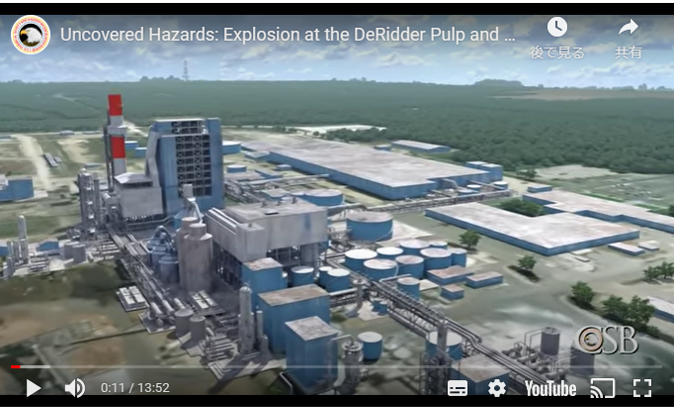
Feburary 8 2017 the packaging Corporation of American’s(PCA’s) DeRidder Louisiana pulp and paper mill.The mill was undergoing a planned maintenance shutdown, when a tank violently exploded, killing three contract workers and injuring seven others. The Chemical Safety Board launched an investigation and found that despite industry good practice guidance to do so, PCA did not apply its process safety management system to the process that included the tank that ultimately exploded. As a result hazards such as the potential for a flammable atmosphere to form within the tank were not adequately evaluated.
Rick:”At the company voluntarily applied at safety management system which is used elsewhere in the mill to the process that included the tank. The conditions that allowed the fatal explosion could have been eliminated or controlled and this tragic incident could have been prevented.
2017年2月8日 アメリカ包装業界(PCA)のDeRidder製紙ルイジアナ工場にて計画定修中にタンクが激しい爆発を起こし、3名の社員が死亡し、7名が負傷した。CSBは事故調査を実施し、PCAが爆発したタンクを含むプロセスに対して、化学工業向けのガイダンスが提唱する安全管理システムを運用していなかったことを明らかにした。結果として、タンク内で爆発性雰囲気が形成される危険性が適切に評価されていなかった。
リック・エングラー(CSB委員)「この企業では、タンクを含むプロセスに対し、任意で安全管理システムを適用していた。致命的な爆発を起こすような危険な状態は排除もしくは制御可能であり、この重大事故は防げたであろう。」
ナレーション②

PCA’s DeRidder mill produces container board that is used in products such as boxes and container board displays. The container board in made from pulp produced at the facility. The process of creating pulp generates vapors. The vapors which contain water turpentine and various sulfur compounds are then collected and separated. The vapors are separated in a turpentine stripping column. Most of the turpentine is removed an sent to a condenser. The vapor is remaining condensed to a liquid containing mostly water but also residual amounts of the sulfur compounds and turpentine.
DeRidder 工場では段ボール箱などに使われる原紙を製造していた。段ボール原紙は同じ敷地内で作られるパルプを原料とし、パルプ製造においては蒸気の発生があった。その蒸気は水やテレビン油、そのた様々な硫化物などが含まれており、回収・分離されるプロセスだった。テレビン油の大部分は除去塔で分離され、凝縮器に送られる。残った蒸気は凝縮され、ほとんどが水だが、硫化物やテレピン油も含む液体となる。
ナレーション③

The liquid is known as foul condensate. The foul condensate is sent from the stripping column to an approximately 100,000 gallon capacity tank used to store the liquid at or close to atmospheric pressure. The foul condensate tank is primarily used to regulate the flow of liquid between the turpentine stripping column upstream and a downstream unit that removes the remaining sulfur components from the foul condensate. During the February 8 incident the mill was undergoing an annual shutdown. During which employees and contract workers performed maintenance inspection and upgrade tasks throughout the facility. One task was to repair the water piping located above and connected to the foul condensate tank. The piping had shifted and cracked months earlier. The repair required welding on the piping commonly referred to as hot work . To prepare for the hot work, valves were closed leading into and out of the foul condensate tank while 10 feet of liquid remained inside . The foul condensate was left within the tank partially because there were no plans to work directly on the tank during the outage.
この液体は蒸解黒液として知られていた。その黒液は除去塔から約380m3のタンクに送られ、大気圧付近で貯留されていた。このタンクは主に上流側のテレビン油除去塔と下流側の硫化物除去プロセスのバッファータンクとして機能していた。事故が起きた2月8日は定修中であり、従業員たちは保守検査や、更新業務を行っていた。定修工事の一つに黒液タンクにつながる架空された水配管の補修があった。その配管は数か月前から変形し、亀裂が入っており、火気工事といわれる溶接作業が必要だった。タンクの中には3mほど液が在中しており、火気工事の準備としてタンクにつながる配管のバルブをすべて閉めた。タンク上で直接作業することはないという理由から、タンクを空にすることはなかった。
ナレーション④

The company also assumed that the tank contained mostly water was sealed off from the atmosphere and did not pose a safety risk. These assumptions however were incorrect. Residual turpentine which is normally present in foul condensate collected on top of the liquid in the tank due to its density. The follow condensate tank was designed so that by changing the height of the liquid level inside the tank. The residual turpentine would be skimmed off and sent to a turpentine recovery system. But in the months leading up to the incident the turpentine was not removed because there was confusion as to which department at the mill was responsible for operation of the foul condensate tank. Due to this lack of defined responsibility the valve designed to direct skimmed turpentine to the mills turpentine recovery system remained closed during those months. As a result more flammable turpentine was in the foul condensate tank during the shutdown than anyone expected.
またタンク内のほとんどは水と思っており、また外気から隔離されているため、爆発リスクがあるとは考えていなかったが、これらの思い込みは間違っていた。黒液に含まれるテレピン油は密度差から、液体表面に分液しており。これを利用して、タンク内部は液面が上昇するとテレピン油のみ分離され、回収系に送られる仕組みになっていた。しかしながら事故当時は、このタンクの管理部署が明確になっていなかったため、回収系につながるバルブが数か月もの間、閉まった状態になっており、テルピン油が適切に除去されていなかった。結果として、定修中、想定していたよりも多くのテルピン油がタンク内に在中していた。
ナレーション⑤
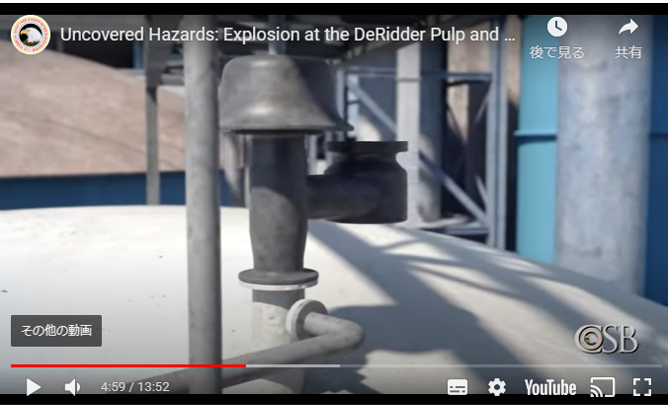
In addition it is normal for there to be vapors inside the foul condensate tank in the space above the liquid. Although those vapors can be flammable there is not supposed to be enough oxygen in the tank to support combustion. But because the tank had been isolated from the process during the annual shutdown, the contents of the tank likely cooled from its normal operating temperature creating low pressure conditions within the tank. This most likely triggered a relief valve on the tanks roof to add more air to avoid damaging the tank from a vacuum created by low pressure. The vacuum relief valve was likely one of the few potential sources that allowed enough air into the tank to create an explosive atmosphere.
加えて、普段からこの黒液タンク内の空間部には可燃性蒸気があるものの、爆発性混合気を形成するには不十分な酸素量しかないとみなされていた。しかしながら、定修により長期間通常プロセスから切り離されたため、通常運転温度よりも下がり、タンク内圧は低くなっていた。この現象がきっかけとなり、タンク変形防止のため設置されたリリーフバルブ(ブリザー弁)を作動させ、タンク内に空気が流入したと思われる。このリリーフバルブがタンク内で爆発性混合気を形成させた数少ない要因の一つだと考えられている。
ナレーション⑥
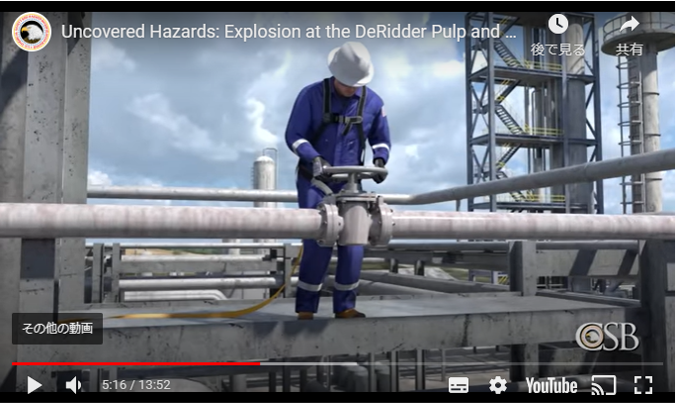
The day before the incident, in preparation for repair, the water piping was isolated from the foul condensate tank and the rest of the process by closed valves. And the piping was separated physically from the tank. Around 8 a.m. on February 8 a mill employee used a gas detector to check for a flammable atmosphere in and around the water piping and found none. The company then issued a hot work permit for the welding work. But even though a flammable atmosphere was not present outside the tank, there was a flammable atmosphere inside the tank. Without knowing that the vapors inside the tank posed a serious hazard, 3 contract workers began welding on the water piping located above it.
事故前日、工事準備として黒液タンクやその他設備とつながる水配管のバルブを閉め、縁切りを行った。2月8日朝8時ごろ、工事対象の水配管周辺の可燃性ガスなしを確認し、火気使用許可を発行した。しかし、この時タンク外部には可燃性ガスはなかったが、内部には存在していた。この重大な潜在危険を認知しないまま、3人の作業員が黒液タンク上部に位置する水配管の溶接作業を開始してしまった。
ナレーション⑦

The CSB was unable to determine an exact ignition source, but it is likely that sparks or molten slag produced from the hot work landed on or near the foul condensate tank heating up the tank wall, or igniting its contents, or it is possible that the hot work was complete but as the tools were lowered a welding torch fell and created an electric arc on the tank, or expand piping. Regardless the CSB determined that hot work activities likely ignited the flammable vapors and liquid turpentine inside the foul condensate tank. At 11:05 a.m. there was a massive explosion. The tank separated from its base and launched up and over a six story building landing approximately 375 feet away. Three people were killed and seven were injured. All were contract employees working near the fall condensate tank.
CSBの調査において着火源は断定はできてないが、溶接によって生じた火花や、溶けた金属がタンク付近に落下し、タンク壁温を上昇させたか、もしくは直接タンク内に火をつけた、または溶接作業は完了したが溶接トーチを下におろした際タンクや配管にアーク放電が発生したのだろうと考えている。とにかく火気作業が原因で、タンク内のテルピン油に着火したことは確かである。午前11時05分、大規模な爆発が発生した。タンクは基礎から離れて高く打ちあがり6階建ての建屋を超えおよそ114m先まで吹き飛んだ。タンク近くで作業していた従業員の内3人が死亡し、7人が負傷した。
ナレーション⑧

Rick:”In our investigation we found that PCA missed opportunities to identify, evaluate and control the hazards that led to the explosion. That is because a process safety management system was not applied to the process that includes the foul condensate tank.”
OSHA’s process safety management or PSM standard requires (facilities that use highly hazardous substances) to have a process safety management system in place to protect workers from catastrophic incidents. But this safeguard was not required for most of the process system that included the foul condensate tank known as the non condensable gas system. The CSB notes that although not required by federal regulation, industry good practice guidance recommends having a robust safety management system to manage the hazards related to processing non condensable gases. But despite these recommendations PCA did not voluntarily apply its process safety management system required by OSHA elsewhere in the mill to the non condensable gas system.As a result PCA never conducted a process hazard analysis of the non condensable gas system. A process hazard analysis or PHA is a comprehensive assessment of potential hazards involved in an industrial process. A properly conducted PHA likely would have identified and called for elimination of the flammable atmosphere inside the foul condensate tank during the annual shutdown.
リック・エングラー(CSB委員)「PCAでは、この黒液タンクに対して安全管理システムを適用しておらず、爆発事故につながる危険性について、特定、評価し管理する機会が欠けていたことが、事故調査の中で明らかとなった。」
OSHAの安全管理要領では危険性の高い化学物質を扱う設備に対しては、プロセス安全管理システムを運用することを規定している。しかしこの安全管理要領では凝縮操作を行わない今回のタンクのようなプロセスに対してはほぼ適用を要求されていなかった。当局規制においては求められてないが、工業技術規範ガイドではこのような、凝縮操作のないタンクについても堅牢性の高い安全管理システムを用意しておくことを推奨している。このような推奨事項はあったが、PCAは自主的に適用することはなく、工場内のほか同様のプロセスについても危険源解析を行ったことがなかった。PHA(プロセス危険源解析)は工業にかかわる包括的なアセスメントであり、正しく実施されていれば、定修中の黒液タンク内の可燃性ガスを特定し、危険を排除できていただろう。
ナレーション⑨

On the day of the incident the 30-foot tall tank contained a liquid level of about 10 feet and PCA employees thought that the remaining 20 feet of vapor space lacked enough air to support combustion. But a PHA could have recognized the potential for air to enter the tank and create a flammable atmosphere which could have identified the need for the company to implement effective safeguards to prevent an explosion. For example the tank could have been drained and purged as part of the annual shutdown.
Steve Salman is assistant director of the health safety and environment department of the United Steelworkers the Union which represents PCA employees.
“Decisions were made to not drain flush and leave the foul condensate tank open. And that is different than what it’s been in the past. Our members felt that needed to be done. We believe that had the tank been drained flushed and left open that could have helped prevent this unwanted event.”
事故の起きたタンクについても、9m高さのタンクの2/3程度は入っていると、思いこまれていたが実際には1/3程度しか液面がなく爆発性雰囲気を形成する空気が入り込みやすい状況だった。PHAがしっかりできていたなら、この爆発危険性に気づくことができ、例えば定修中はタンク内液を空にしておくなど、適切な安全対策をとることができていただろう。
スティーブ・サルマン氏(米国鉄鋼労働組合、健康・環境部副部長、PCA従業員代表)「黒液タンクは実液在中のまま大気開放で置かれており、過去の仕舞の状況とは違っていた。組合としても、このタンクは全量排出し空にしてから大気開放にしておけばこの望ましくない事故を防げていただろうと考えています。」
ナレーション⑩

Other safeguards include procedures to prohibit hot work near the foul condensate tank while it contained flammable vapor. Low pressure alarms to alert workers that the vacuum relief valve may open and allow air into the tank. Oxygen analyzers that let workers know that a dangerous amount of air was in the tank. Interlocks to automatically reduce the concentration of oxygen by adding an inert gas so that a falmmable atmosphere does not form. Or an inherently safer tank designed to withstand full vacuum conditions eliminating the need for a vacuum relief valve and the potential risks associated with it.
その他に安全対策として、以下が挙げられる。
・可燃性蒸気を含むタンクの近くでは溶接作業を行わない。
・ブリザー弁を通して空気が混入するような、内圧低下の際はアラームを発報する。
・タンク内への空気混入を検知できるよう酸素濃度計を設置する。
・自動的に不活性ガスを封入して酸素濃度を下げるインターロックを設ける。
・もしくは、本質的な安全対策として、空気混入リスクのあるリリーフバルブを設けなくてもいいように真空対応のタンクにする
ナレーション⑪

The foul condensate tank was located between two operations areas, the pulp mill and the powerhouse. But because the DeRidder mill did not apply its process safety management system to the foul condensate tank, the company did not clearly identify who was responsible for it leading to confusion within the mill workforce. Over time, this ambiguity led to few operators knowing much about the tank, its contents and it’s explosion potential.
Steve”Training and education needed to be provided to the operators and workers in the area. Workers are not aware of the hazards they were not provided with that information. They felt that this tank would not be an issue.”
黒液タンクはパルプ工場と電力課の間にあり、DeRidderは管理部署を明確にしていなかったため、従業員の間でも混乱が生じていた。このあいまいな管理のせいで、時間がたつにつれて、このタンクに何が入っていてどんな危険があるのか知る者はほとんどいなくなっていた。
スティーブ・サルマン氏「工場で働く従業員に対して教育訓練は必須である。従業員は教えられてない危険については認識することはなく、このタンクに危険が潜んでるなどとは思っていなかった。」
ナレーション⑫
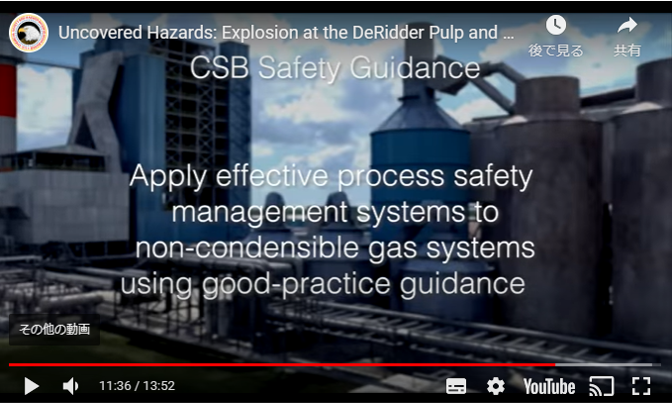
In its final report, the CSB provided safety guidance to pulp and paper mills that operate non condensable gas systems which includes all foul condensate tanks. The guidance includes:
・Apply effective process safety management systems to non condensable gas systems using good practice guidance.
・Consider expanding the boundaries of process safety management programs beyond the units covered by OSHA’s PSM standard.
・Apply industry standards for explosion prevention and safety interlock systems.
・Provide workers with periodic training to ensure they understand all process safety hazards applicable to areas of their responsibility, including the safety conditions needed to permit hot work.
最終報告書においてCSBは、プロセス製紙会社全体に対して、以下のような指導を行った。
・黒液タンクのような凝縮性ガスを取り扱わないプロセスについても、工業技術規範ガイドを参考に、効果的な安全対策を行うこと
・OSHAの安全管理要領で記載されている、設備単位の考え方を超えて、安全管理を行うプロセスの区切り方を広げること。
・防爆の工業規格を適用し、インターロックを導入すること。
・従業員が、それぞれの管轄プロセスに潜む危険性(火気使用のためにどう安全な状態にしたらよいかなど)を理解できるよう、定期的な教育訓練を実施すること。
ナレーション⑬

Also in its final report the CSB reiterated a 2002 recommendation to OSHA to revise the PSM standard to cover atmospheric storage tanks that could be involved in a potential catastrophic release. As a result of being interconnected to a covered process with 10,000 pounds of a flammable substance.
Rick:””That recommendation has not yet been implemented and explosions like the one at PCA continue to occur. We urge OSHA to act on this important safety recommendation to prevent future incidents. What’s unique about pulp and paper mills it’s not just a mill that makes paper. It needs to be viewed as a chemical plant that makes paper and handled in that fashion around process safety management to prevent tragedies from happening. Preventable incidents like the one at PCA reveal flaws in a facility’s process safety management system. We believe our safety guidance and recommendation for stronger OSHA safeguards will help prevent these tragic incidents. Thank you for watching this CSB safety video.”
またCSBはOSHAに対する2002年の推奨事項である、爆発可能性のある大気雰囲気下での貯蔵タンクも安全管理要領の対象とすることを再度求めた(結果として新たに4.5ton以上の可燃性物質が管理対象となる)。
リック・エングラー(CSB委員)「その推奨事項はまだ実施されておらず、今回のPCAのような爆発事故がまた起こるかもしれない。我々はOHSAに対して、将来の事故防止のために上記改善を行うよう強く働きかけている。今回の事例は特徴的ではあるがであるが、製紙工場に限ったことではなく、一つの化学工場の事例としてとらえ、悲惨な事故を防ぐためにプロセス安全管理を確実に実施する必要がある。今回の事故のように発生防止が可能だった事例は、設備のプロセス安全管理システムにおける欠陥を明確にした。我々は、今回行った指導や、OSHAの改訂が同様の事故再発防止につながると確信しています。CSBの化学安全に関する動画をご視聴いただきありがとうございました。」

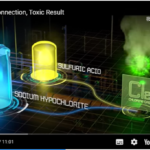

コメント